The Matricellular Protein Hevin Is Involved in Alcohol Use Disorder
Abstract
1. Introduction
2. Materials and Methods
2.1. Human Samples
2.2. Animals and Treatments
2.3. Sample Preparation
2.4. Real-Time Reverse Transcription Polymerase Chain Reaction (RT-qPCR)
2.5. Western Blot
2.6. Intermittent Ethanol Access Schedule (IEA) in Hevin Knockdown Mice
2.7. Immunohistochemistry
2.8. Statistical Analysis
3. Results
3.1. Hevin Expression in Postmortem Human Brains of Subjects with AUD
3.2. Hevin Protein Expression in Mouse Brain after Ethanol Administration
3.3. Hevin Protein Expression in Mouse Plasma after Ethanol Treatment
3.4. Behavioral Consequences of Hevin Downregulation in NAc Astrocytes on Ethanol Consumption
4. Discussion
Supplementary Materials
Author Contributions
Funding
Institutional Review Board Statement
Informed Consent Statement
Data Availability Statement
Conflicts of Interest
References
- Heilig, M.; MacKillop, J.; Martinez, D.; Rehm, J.; Leggio, L.; Vanderschuren, L.J.M.J. Addiction as a brain disease revised: Why it still matters, and the need for consilience. Neuropsychopharmacology 2021, 46, 1715–1723. [Google Scholar] [CrossRef] [PubMed]
- Rehm, J.; Mathers, C.; Popova, S.; Thavorncharoensap, M.; Teerawattananon, Y.; Patra, J. Global burden of disease and injury and economic cost attributable to alcohol use and alcohol-use disorders. Lancet 2009, 373, 2223–2233. [Google Scholar] [CrossRef]
- Nutt, D.J.; King, L.A.; Phillips, L.D. Drug harms in the UK: A multicriteria decision analysis. Lancet 2010, 376, 1558–1565. [Google Scholar] [CrossRef] [PubMed]
- WHO. World Health Organization. Global Status Report on Alcohol and Health. 2018. Available online: https://www.who.int/publications/i/item/9789241565639 (accessed on 27 September 2018).
- Spanagel, R.; Zink, M.; Sommer, W.H. Alcohol: Neurobiology of Alcohol Addiction. In Neurosci. 21st Century Basic Clin; Pfaff, D.W., Volkow, N.D., Eds.; Springer: New York, NY, USA, 2016; pp. 3593–3623. [Google Scholar] [CrossRef]
- Weiss, F.; Porrino, L.J. Behavioral Neurobiology of Alcohol Addiction: Recent Advances and Challenges. J. Neurosci. 2002, 22, 3332–3337. [Google Scholar] [CrossRef] [PubMed]
- Abrahao, K.P.; Salinas, A.G.; Lovinger, D.M. Alcohol and the Brain: Neuronal Molecular Targets, Synapses, and Circuits. Neuron 2017, 96, 1223–1238. [Google Scholar] [CrossRef]
- Koob, G.F.; Volkow, N.D. Neurobiology of addiction: A neurocircuitry analysis. Lancet Psychiatry 2016, 3, 760–773. [Google Scholar] [CrossRef]
- Becker, H.C. Alcohol dependence, withdrawal, and relapse. Alcohol. Res. Health 2008, 31, 348–361. [Google Scholar]
- Koob, G.F.; Le Moal, M. Plasticity of reward neurocircuitry and the ‘dark side’ of drug addiction. Nat. Neurosci. 2005, 8, 1442–1444. [Google Scholar] [CrossRef]
- Sliedrecht, W.; de Waart, R.; Witkiewitz, K.; Roozen, H.G. Alcohol use disorder relapse factors: A systematic review. Psychiatry Res. 2019, 278, 97–115. [Google Scholar] [CrossRef]
- Nagai, J.; Rajbhandari, A.K.; Gangwani, M.R.; Hachisuka, A.; Coppola, G.; Masmanidis, S.C.; Fanselow, M.S.; Khakh, B.S. Hyperactivity with Disrupted Attention by Activation of an Astrocyte Synaptogenic Cue. Cell 2019, 177, 1280–1292.e20. [Google Scholar] [CrossRef]
- Wang, J.; Holt, L.M.; Huang, H.H.; Sesack, S.R.; Nestler, E.J.; Dong, Y. Astrocytes in cocaine addiction and beyond. Mol. Psychiatry 2021, 27, 652–668. [Google Scholar] [CrossRef] [PubMed]
- Erickson, E.K.; DaCosta, A.J.; Mason, S.C.; Blednov, Y.A.; Mayfield, R.D.; Harris, R.A. Cortical astrocytes regulate ethanol consumption and intoxication in mice. Neuropsychopharmacology 2020, 46, 500–508. [Google Scholar] [CrossRef]
- Bull, C.; Freitas, K.C.C.; Zou, S.; Poland, R.S.; Syed, W.; Urban, D.J.; Minter, S.C.; Shelton, K.L.; Hauser, K.F.; Negus, S.S.; et al. Rat Nucleus Accumbens Core Astrocytes Modulate Reward and the Motivation to Self-Administer Ethanol after Abstinence. Neuropsychopharmacology 2014, 39, 2835–2845. [Google Scholar] [CrossRef]
- Erickson, E.K.; Farris, S.P.; Blednov, Y.A.; Mayfield, R.D.; Harris, R.A. Astrocyte-specific transcriptome responses to chronic ethanol consumption. Pharm. J. 2018, 18, 578–589. [Google Scholar] [CrossRef]
- Erickson, E.K.; Blednov, Y.A.; Harris, R.A.; Mayfield, R.D. Glial gene networks associated with alcohol dependence. Sci. Rep. 2019, 9, 1–13. [Google Scholar] [CrossRef]
- Trindade, P.; Hampton, B.; Manhães, A.C.; Medina, A.E. Developmental alcohol exposure leads to a persistent change on astrocyte secretome. J. Neurochem. 2016, 137, 730–743. [Google Scholar] [CrossRef]
- Pignataro, L.; Varodayan, F.P.; Tannenholz, L.E.; Protiva, P.; Harrison, N.L. Brief alcohol exposure alters transcription in astrocytes via the heat shock pathway. Brain Behav. 2013, 3, 114–133. [Google Scholar] [CrossRef]
- Christopherson, K.S.; Ullian, E.M.; Stokes, C.C.A.; Mullowney, C.E.; Hell, J.W.; Agah, A.; Lawler, J.; Mosher, D.F.; Bornstein, P.; Barres, B.A. Thrombospondins Are Astrocyte-Secreted Proteins that Promote CNS Synaptogenesis. Cell 2005, 120, 421–433. [Google Scholar] [CrossRef]
- Gan, K.J.; Südhof, T.C. SPARCL1 promotes excitatory but not inhibitory synapse formation and function independent of neurexins and neuroligins. J. Neurosci. 2020, 40, 8088–8102. [Google Scholar] [CrossRef] [PubMed]
- Kucukdereli, H.; Allen, N.J.; Lee, A.T.; Feng, A.; Ozlu, M.I.; Conatser, L.M.; Chakraborty, C.; Workman, G.; Weaver, M.; Sage, E.H.; et al. Control of excitatory CNS synaptogenesis by astrocyte-secreted proteins Hevin and SPARC. Proc. Natl. Acad. Sci. USA 2011, 108, E440–E449. [Google Scholar] [CrossRef] [PubMed]
- Murphy-Ullrich, J.E.; Sage, E.H. Revisiting the matricellular concept. Matrix Biol. 2014, 37, 1–14. [Google Scholar] [CrossRef]
- Singh, S.K.; Stogsdill, J.A.; Pulimood, N.S.; Dingsdale, H.; Kim, Y.H.; Pilaz, L.-J.; Kim, I.H.; Manhaes, A.C.; Rodrigues, W.S., Jr.; Pamukcu, A.; et al. Astrocytes Assemble Thalamocortical Synapses by Bridging NRX1α and NL1 via Hevin. Cell 2016, 164, 183–196. [Google Scholar] [CrossRef] [PubMed]
- Miguel-Hidalgo, J.J. Molecular Neuropathology of Astrocytes and Oligodendrocytes in Alcohol Use Disorders. Front. Mol. Neurosci. 2018, 11, 78. [Google Scholar] [CrossRef] [PubMed]
- Risher, W.C.; Patel, S.; Kim, I.H.; Uezu, A.; Bhagat, S.; Wilton, D.K.; Pilaz, L.J.; Singh Alvarado, J.; Calhan, O.Y.; Silver, D.L.; et al. Astrocytes refine cortical connectivity at dendritic spines. eLife 2014, 3, e04047. [Google Scholar] [CrossRef]
- Girard, J.-P.; Springer, T.A. Modulation of Endothelial Cell Adhesion by Hevin, an Acidic Protein Associated with High Endothelial Venules. J. Biol. Chem. 1996, 271, 4511–4517. [Google Scholar] [CrossRef]
- Johnston, I.G.; Paladino, T.; Gurd, J.W.; Brown, I.R. Molecular cloning of SC1: A putative brain extracellular matrix glycoprotein showing partial similarity to osteonectin/BM40/SPARC. Neuron 1990, 4, 165–176. [Google Scholar] [CrossRef]
- Lively, S.; Brown, I.R. The extracellular matrix protein SC1/hevin localizes to multivesicular bodies in bergmann glial fibers in the adult rat cerebellum. Neurochem. Res. 2010, 35, 315–322. [Google Scholar] [CrossRef] [PubMed]
- Mongrédien, R.; Erdozain, A.M.; Dumas, S.; Cutando, L.; del Moral, A.N.; Puighermanal, E.; Amin, S.R.; Giros, B.; Valjent, E.; Meana, J.J.; et al. Cartography of hevin-expressing cells in the adult brain reveals prominent expression in astrocytes and parvalbumin neurons. Brain Struct. Funct. 2019, 224, 1219–1244. [Google Scholar] [CrossRef]
- Nuñez-Delmoral, A.; Brocos-Mosquera, I.; Vialou, V.; Callado, L.F.; Erdozain, A.M. Characterization of Hevin (SPARCL1) Immunoreactivity in Postmortem Human Brain Homogenates. Neuroscience 2021, 467, 91–109. [Google Scholar] [CrossRef]
- Soderling, J.A.; Reed, M.J.; Corsa, A.; Sage, E.H. Cloning and Expression of Murine SC1, a Gene Product Homologous to SPARC. J. Histochem. Cytochem. 1997, 45, 823–835. [Google Scholar] [CrossRef]
- Vialou, V.; Robison, A.; LaPlant, Q.C.; Iii, H.E.C.; Dietz, D.; Ohnishi, Y.N.; Mouzon, E.; Rush, A.J.; Watts, E.L.; Wallace, D.L.; et al. ΔFosB in brain reward circuits mediates resilience to stress and antidepressant responses. Nat. Neurosci. 2010, 13, 745–752. [Google Scholar] [CrossRef]
- Bahi, A.; Dreyer, J.-L. Involvement of nucleus accumbens dopamine D1 receptors in ethanol drinking, ethanol-induced conditioned place preference, and ethanol-induced psychomotor sensitization in mice. Psychopharmacology 2012, 222, 141–153. [Google Scholar] [CrossRef]
- Nocjar, C.; Middaugh, L.D.; Tavernetti, M. Ethanol consumption and place-preference conditioning in the alcohol-preferring C57BL/6 mouse: Relationship with motor activity patterns. Alcohol. Clin. Exp. Res. 1999, 23, 683–692. [Google Scholar] [CrossRef] [PubMed]
- Bradford, M.M. A rapid and sensitive method for the quantitation of microgram quantities of protein utilizing the principle of protein-dye binding. Anal. Biochem. 1976, 72, 248–254. [Google Scholar] [CrossRef] [PubMed]
- Muguruza, C.; Miranda-Azpiazu, P.; Díez-Alarcia, R.; Morentin, B.; González-Maeso, J.; Callado, L.F.; Meana, J.J. Evaluation of 5-HT2A and mGlu2/3 receptors in postmortem prefrontal cortex of subjects with major depressive disorder: Effect of antidepressant treatment. Neuropharmacology 2014, 86, 311–318. [Google Scholar] [CrossRef] [PubMed]
- Portero-Tresserra, M.; Gracia-Rubio, I.; Cantacorps, L.; Pozo, O.J.; Gómez-Gómez, A.; Pastor, A.; López-Arnau, R.; de la Torre, R.; Valverde, O. Maternal separation increases alcohol-drinking behaviour and reduces endocannabinoid levels in the mouse striatum and prefrontal cortex. Eur. Neuropsychopharmacol. 2018, 28, 499–512. [Google Scholar] [CrossRef]
- Dean, B.; Hyde, T.M.; Kleinman, J. Using CNS Autopsy Tissue in Psychiatric Research: A Practical Guide; CRC Press: Boca Raton, FL, USA, 2019. [Google Scholar] [CrossRef]
- Seghier, M.L.; Price, C.J. Interpreting and Utilising Intersubject Variability in Brain Function. Trends Cogn. Sci. 2018, 22, 517–530. [Google Scholar] [CrossRef]
- Brekken, R.A.; Sullivan, M.M.; Workman, G.; Bradshaw, A.D.; Carbon, J.; Siadak, A.; Murri, C.; Framson, P.E.; Sage, E.H. Expression and Characterization of Murine Hevin (SC1), a Member of the SPARC Family of Matricellular Proteins. J. Histochem. Cytochem. 2004, 52, 735–748. [Google Scholar] [CrossRef]
- Weaver, M.S.; Workman, G.; Cardo-Vila, M.; Arap, W.; Pasqualini, R.; Sage, E.H. Processing of the Matricellular Protein Hevin in Mouse Brain Is Dependent on ADAMTS4. J. Biol. Chem. 2010, 285, 5868–5877. [Google Scholar] [CrossRef] [PubMed]
- Fish, E.; DeBold, J.; Miczek, K. Repeated alcohol: Behavioral sensitization and alcohol-heightened aggression in mice. Psychopharmacology 2002, 160, 39–48. [Google Scholar] [CrossRef]
- Weaver, M.; Workman, G.; Schultz, C.R.; Lemke, N.; Rempel, S.A.; Sage, E.H. Proteolysis of the matricellular protein hevin by matrix metalloproteinase-3 produces a SPARC-like fragment (SLF) associated with neovasculature in a murine glioma model. J. Cell. Biochem. 2011, 112, 3093–3102. [Google Scholar] [CrossRef] [PubMed]
- McCullumsmith, R.; Hammond, J.H.; Shan, D.; Meador-Woodruff, J.H. Postmortem Brain: An Underutilized Substrate for Studying Severe Mental Illness. Neuropsychopharmacology 2013, 39, 65–87. [Google Scholar] [CrossRef]
- Gan, K.J.; Südhof, T.C. Specific factors in blood from young but not old mice directly promote synapse formation and NMDA-receptor recruitment. Proc. Natl. Acad. Sci. USA 2019, 116, 12524–12533. [Google Scholar] [CrossRef] [PubMed]
- Avchalumov, Y.; Mandyam, C.D. Synaptic Plasticity and its Modulation by Alcohol. Brain Plast. 2020, 6, 103–111. [Google Scholar] [CrossRef]
- Gass, J.T.; Olive, M.F. Neurochemical and Neurostructural Plasticity in Alcoholism. ACS Chem. Neurosci. 2012, 3, 494–504. [Google Scholar] [CrossRef] [PubMed]
- Ferrer, I.; Fábregues, I.; Rairiz, J.; Galofré, E. Decreased numbers of dendritic spines on cortical pyramidal neurons in human chronic alcoholism. Neurosci. Lett. 1986, 69, 115–119. [Google Scholar] [CrossRef]
- Erdozain, A.M.; Morentin, B.; Bedford, L.; King, E.; Tooth, D.; Brewer, C.; Wayne, D.; Johnson, L.; Gerdes, H.K.; Wigmore, P.; et al. Alcohol-Related Brain Damage in Humans. PLoS ONE 2014, 9, e93586. [Google Scholar] [CrossRef]
- Labisso, W.L.; Raulin, A.-C.; Nwidu, L.L.; Kocon, A.; Wayne, D.; Erdozain, A.M.; Morentin, B.; Schwendener, D.; Allen, G.; Enticott, J.; et al. The Loss of α- and β-Tubulin Proteins Are a Pathological Hallmark of Chronic Alcohol Consumption and Natural Brain Ageing. Brain Sci. 2018, 8, 175. [Google Scholar] [CrossRef]
- Bengochea, O.; Gonzalo, L.M. Effect of chronic alcoholism on the human hippocampus. Histol. Histopathol. 1990, 5, 349–357. [Google Scholar]
- Freund, G.; Anderson, K.J. Glutamate Receptors in the Frontal Cortex of Alcoholics. Alcohol. Clin. Exp. Res. 1996, 20, 1165–1172. [Google Scholar] [CrossRef] [PubMed]
- Michaelis, E.K.; Michaelis, M.L.; Freed, W.J.; Foye, J. Glutamate receptor changes in brain synaptic membranes during chronic alcohol intake. Alcohol Alcohol. Suppl. 1993, 2, 377–381. [Google Scholar]
- Loheswaran, G.; Barr, M.S.; Zomorrodi, R.; Rajji, T.K.; Blumberger, D.M.; Le Foll, B.; Daskalakis, Z.J. Impairment of Neuroplasticity in the Dorsolateral Prefrontal Cortex by Alcohol. Sci. Rep. 2017, 7, 5276. [Google Scholar] [CrossRef] [PubMed]
- Teyssier, J.-R.; Ragot, S.; Chauvet-Gélinier, J.-C.; Trojak, B.; Bonin, B. Activation of a ΔFOSB dependent gene expression pattern in the dorsolateral prefrontal cortex of patients with major depressive disorder. J. Affect. Disord. 2011, 133, 174–178. [Google Scholar] [CrossRef] [PubMed]
- Harrison, N.L.; Skelly, M.J.; Grosserode, E.K.; Lowes, D.C.; Zeric, T.; Phister, S.; Salling, M.C. Effects of acute alcohol on excitability in the CNS. Neuropharmacology 2017, 122, 36–45. [Google Scholar] [CrossRef]
- Pandey, S.C.; Zhang, H.; Ugale, R.; Prakash, A.; Xu, T.; Misra, K. Effector Immediate-Early Gene Arc in the Amygdala Plays a Critical Role in Alcoholism. J. Neurosci. 2008, 28, 2589–2600. [Google Scholar] [CrossRef]
- You, C.; Zhang, H.; Sakharkar, A.J.; Teppen, T.; Pandey, S.C. Reversal of deficits in dendritic spines, BDNF and Arc expression in the amygdala during alcohol dependence by HDAC inhibitor treatment. Int. J. Neuropsychopharmacol. 2013, 17, 313–322. [Google Scholar] [CrossRef] [PubMed]
- Zhou, F.C.; Anthony, B.; Dunn, K.W.; Lindquist, W.B.; Xu, Z.C.; Deng, P. Chronic alcohol drinking alters neuronal dendritic spines in the brain reward center nucleus accumbens. Brain Res. 2007, 1134, 148–161. [Google Scholar] [CrossRef]
- Peterson, V.L.; McCool, B.A.; Hamilton, D.A. Effects of ethanol exposure and withdrawal on dendritic morphology and spine density in the nucleus accumbens core and shell. Brain Res. 2015, 1594, 125–135. [Google Scholar] [CrossRef]
- Uys, J.D.; McGuier, N.S.; Gass, J.T.; Griffin, I.I.I.W.C.; Ball, L.E.; Mulholland, P.J. Chronic intermittent ethanol exposure and withdrawal leads to adaptations in nucleus accumbens core postsynaptic density proteome and dendritic spines. Addict. Biol. 2016, 21, 560–574. [Google Scholar] [CrossRef]
- Ji, X.; Saha, S.; Kolpakova, J.; Guildford, M.; Tapper, A.R.; Martin, G.E. Dopamine Receptors Differentially Control Binge Alcohol Drinking-Mediated Synaptic Plasticity of the Core Nucleus Accumbens Direct and Indirect Pathways. J. Neurosci. 2017, 37, 5463–5474. [Google Scholar] [CrossRef]
- Laguesse, S.; Morisot, N.; Shin, J.H.; Liu, F.; Adrover, M.F.; Sakhai, S.A.; Lopez, M.F.; Phamluong, K.; Griffin, W.C.; Becker, H.C.; et al. Prosapip1-Dependent Synaptic Adaptations in the Nucleus Accumbens Drive Alcohol Intake, Seeking, and Reward. Neuron 2017, 96, 145–159.e8. [Google Scholar] [CrossRef]
- Kircher, D.; Aziz, H.; Mangieri, R.A.; Morrisett, R.A. Ethanol Experience Enhances Glutamatergic Ventral Hippocampal Inputs To D1 Receptor-Expressing Medium Spiny Neurons In The Nucleus Accumbens Shell. J. Neurosci. 2019, 3051–3118. [Google Scholar] [CrossRef] [PubMed]
- Koob, G.F.; Volkow, N.D. Neurocircuitry of Addiction. Neuropsychopharmacology 2010, 35, 217–238, Erratum in: Neuropsychopharmacology 2010, 35, 1051. [Google Scholar] [CrossRef]
- Iii, W.C.G.; Haun, H.L.; Hazelbaker, C.L.; Ramachandra, V.S.; Becker, H.C. Increased Extracellular Glutamate In the Nucleus Accumbens Promotes Excessive Ethanol Drinking in Ethanol Dependent Mice. Neuropsychopharmacology 2013, 39, 707–717. [Google Scholar] [CrossRef]
- Cofresí, R.U.; Bartholow, B.D.; Piasecki, T.M. Evidence for incentive salience sensitization as a pathway to alcohol use disorder. Neurosci. Biobehav. Rev. 2019, 107, 897–926. [Google Scholar] [CrossRef] [PubMed]
- Bendik, I.; Schraml, P.; Ludwig, C.U. Characterization of MAST9/Hevin, a SPARC-like protein, that is down-regulated in non-small cell lung cancer. Cancer Res. 1998, 58, 626–629. [Google Scholar] [PubMed]
- Girard, J.-P.; Springer, T.A. Cloning from purified high endothelial venule cells of hevin, a close relative of the antiadhesive extracellular matrix protein SPARC. Immunity 1995, 2, 113–123. [Google Scholar] [CrossRef] [PubMed]
- Klingler, A.; Regensburger, D.; Tenkerian, C.; Britzen-Laurent, N.; Hartmann, A.; Stürzl, M.; Naschberger, E. Species-, organ- and cell-type-dependent expression of SPARCL1 in human and mouse tissues. PLoS ONE 2020, 15, e0233422. [Google Scholar] [CrossRef] [PubMed]
- Lau, C.-Y.; Poon, R.-P.; Cheung, S.-T.; Yu, W.-C.; Fan, S.-T. SPARC and Hevin expression correlate with tumour angiogenesis in hepatocellular carcinoma. J. Pathol. 2006, 210, 459–468. [Google Scholar] [CrossRef]
- Yin, G.N.; Lee, H.W.; Cho, J.-Y.; Suk, K. Neuronal pentraxin receptor in cerebrospinal fluid as a potential biomarker for neurodegenerative diseases. Brain Res. 2009, 1265, 158–170. [Google Scholar] [CrossRef]
- Lively, S.; Moxon-Emre, I.; Schlichter, L.C. SC1/Hevin and Reactive Gliosis after Transient Ischemic Stroke in Young and Aged Rats. J. Neuropathol. Exp. Neurol. 2011, 70, 913–929. [Google Scholar] [CrossRef] [PubMed]
- Lively, S.; Brown, I.R. The Extracellular Matrix Protein SC1/Hevin Localizes to Excitatory Synapses Following Status Epilepticus in the Rat Lithium-Pilocarpine Seizure Model. J. Neurosci. Res. 2008, 86, 2895–2905. [Google Scholar] [CrossRef] [PubMed]
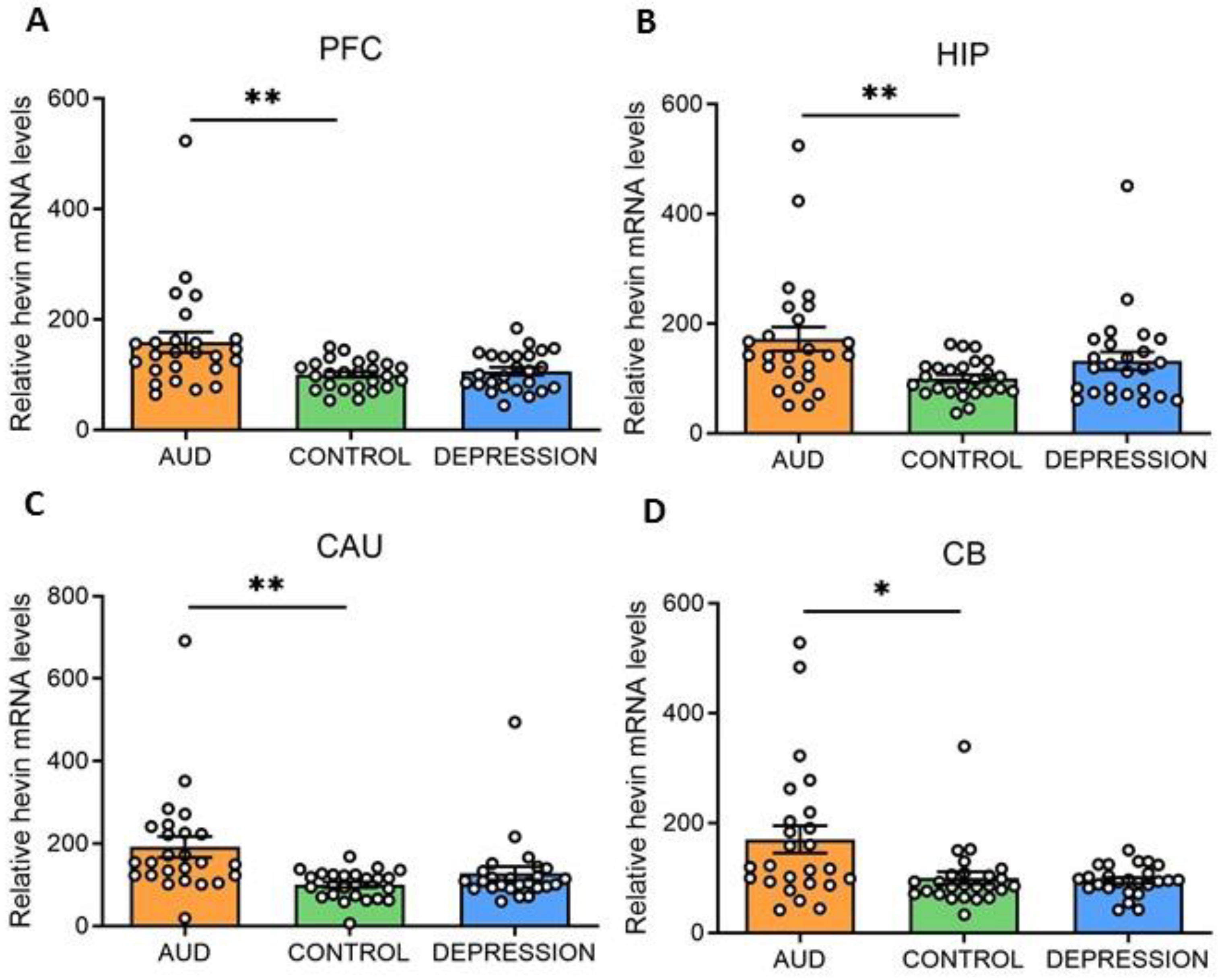
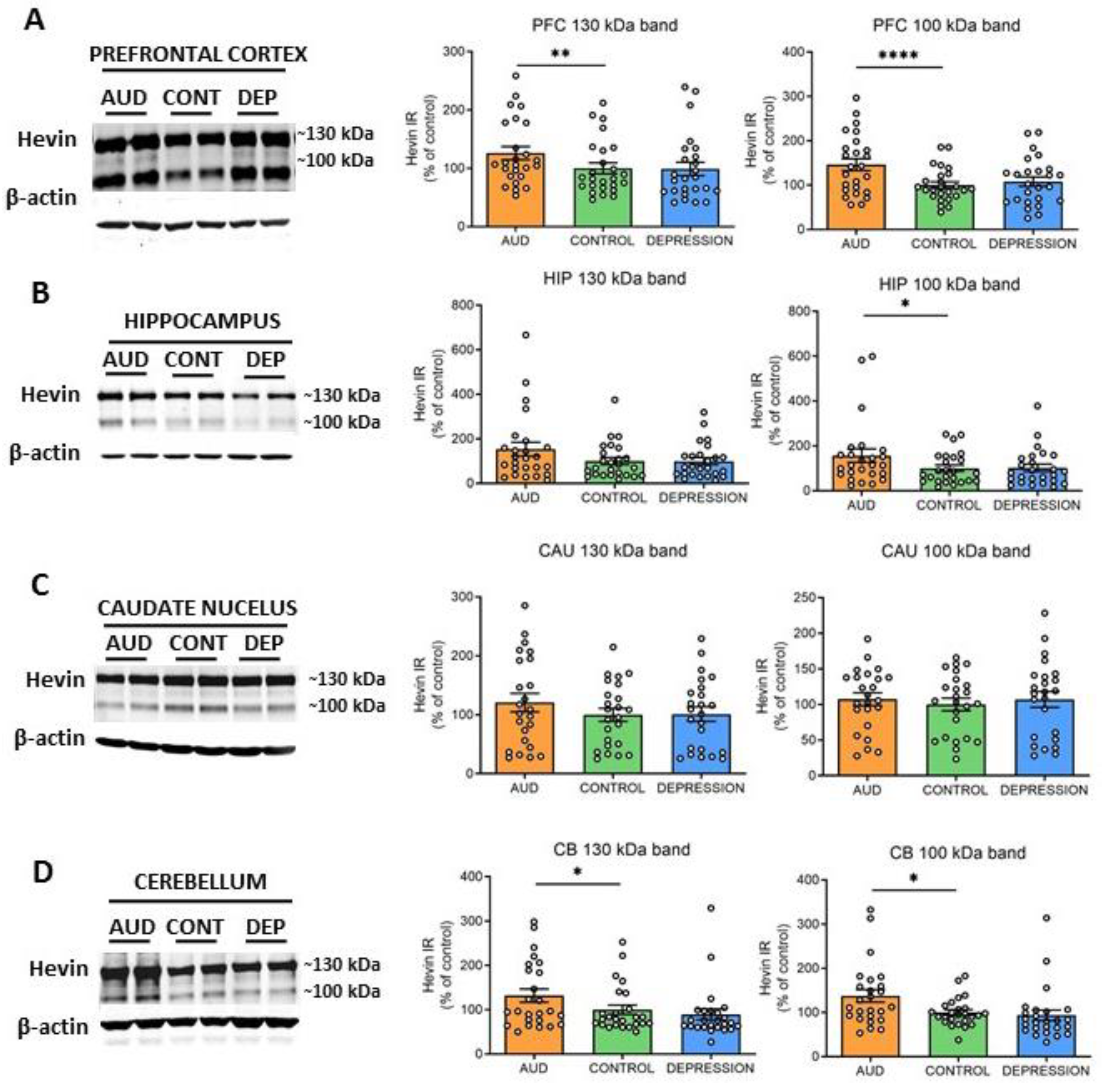
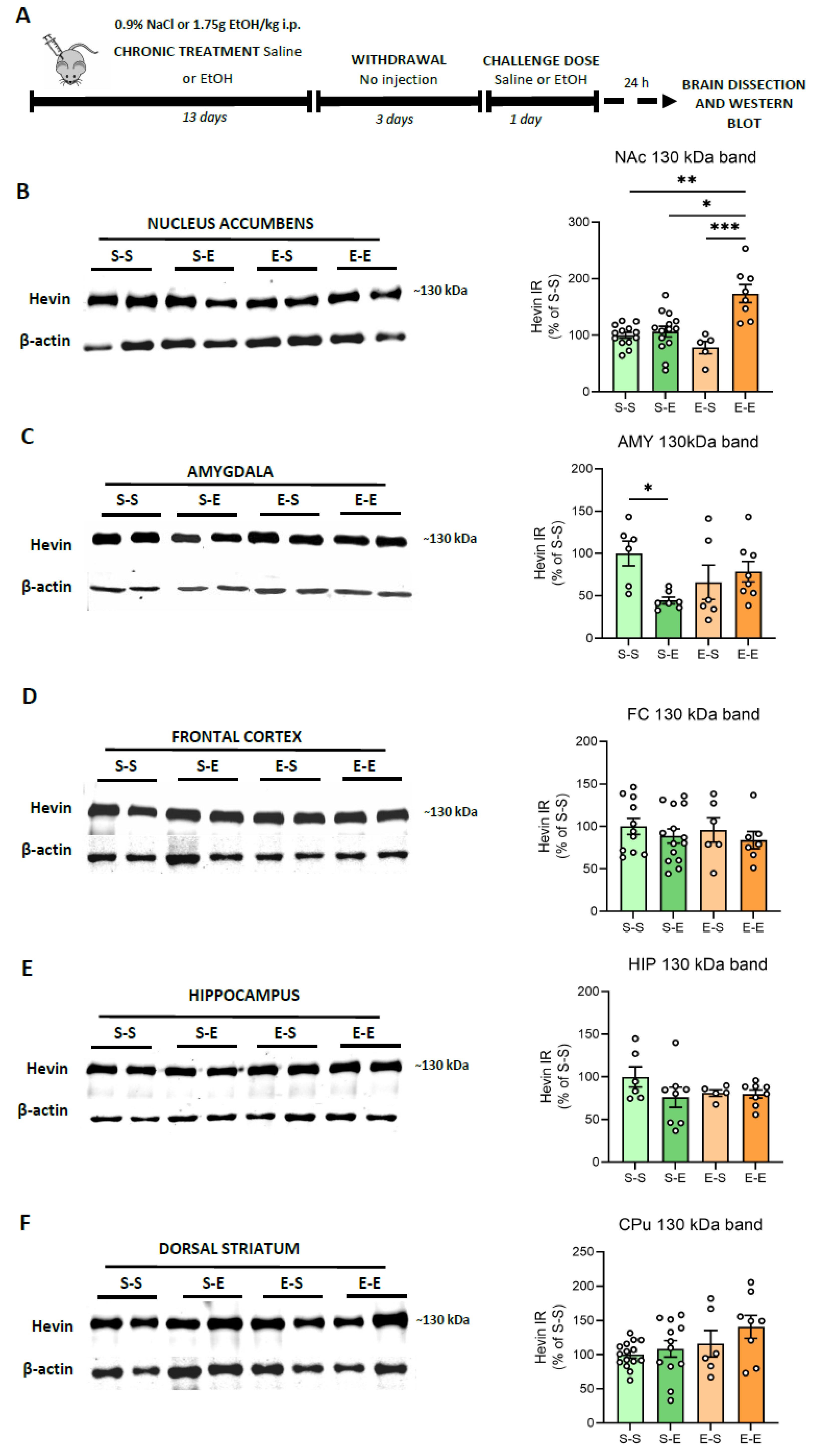
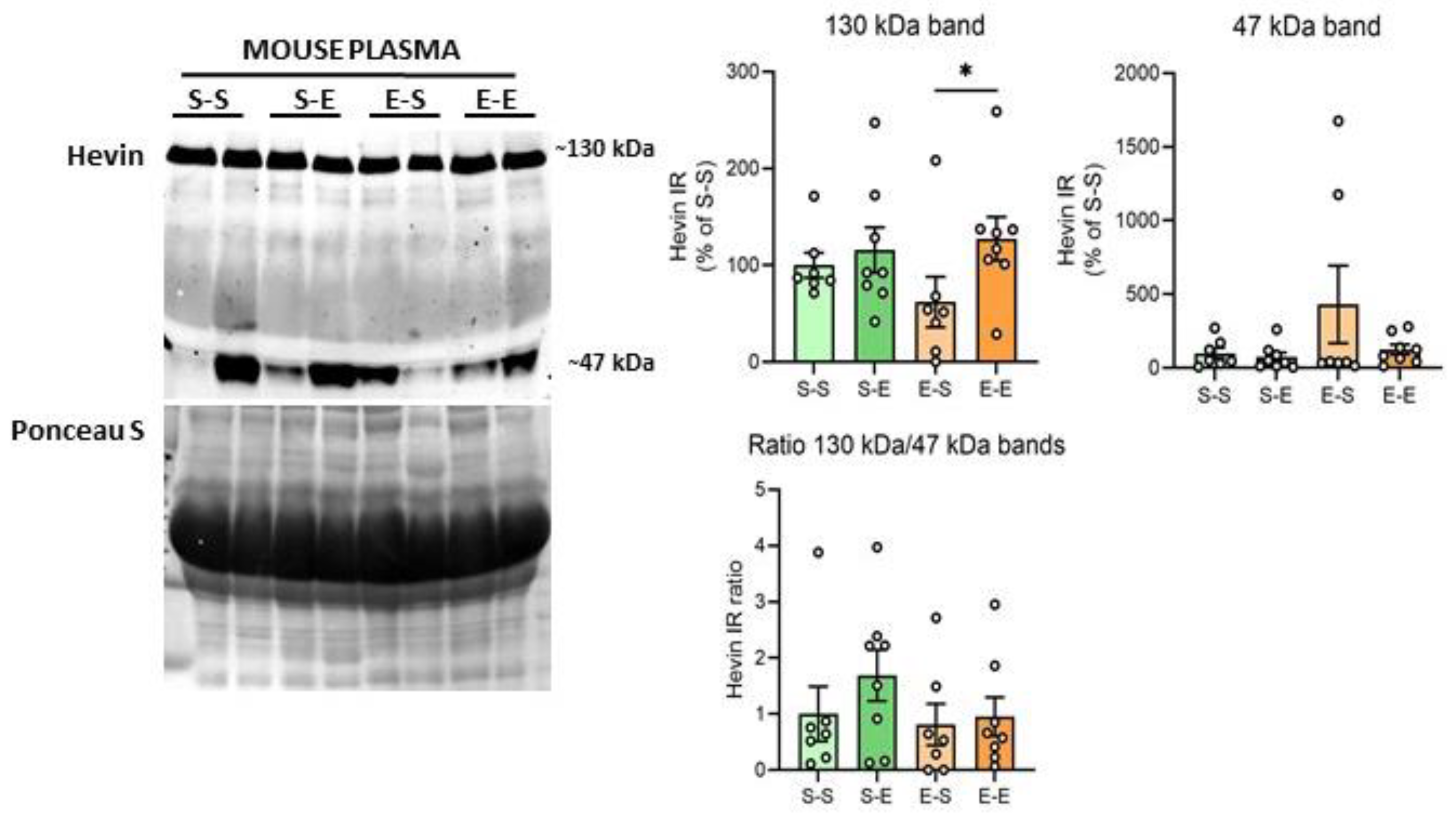
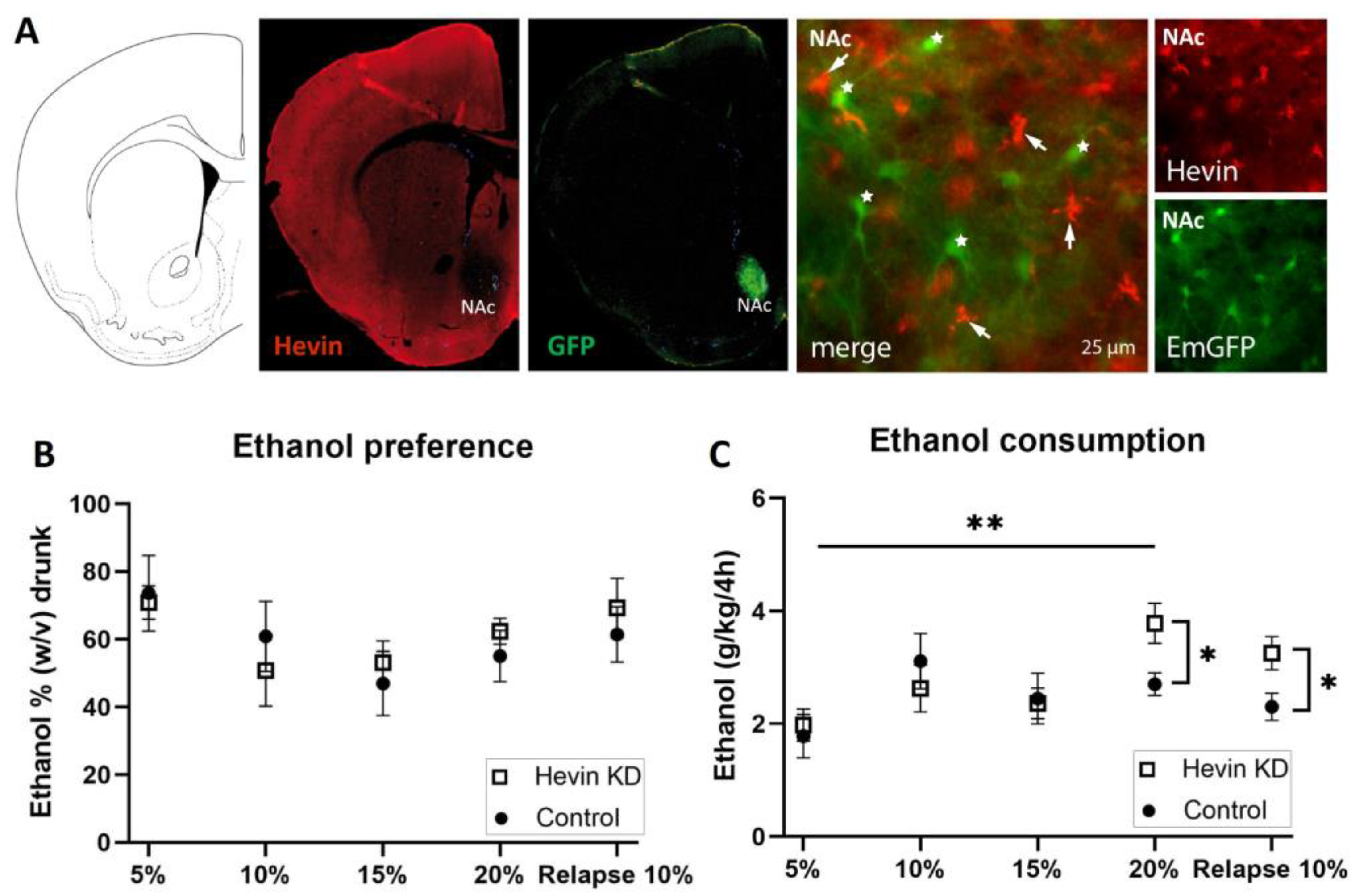
Disclaimer/Publisher’s Note: The statements, opinions and data contained in all publications are solely those of the individual author(s) and contributor(s) and not of MDPI and/or the editor(s). MDPI and/or the editor(s) disclaim responsibility for any injury to people or property resulting from any ideas, methods, instructions or products referred to in the content. |
© 2023 by the authors. Licensee MDPI, Basel, Switzerland. This article is an open access article distributed under the terms and conditions of the Creative Commons Attribution (CC BY) license (https://creativecommons.org/licenses/by/4.0/).
Share and Cite
Nuñez-delMoral, A.; Bianchi, P.C.; Brocos-Mosquera, I.; Anesio, A.; Palombo, P.; Camarini, R.; Cruz, F.C.; Callado, L.F.; Vialou, V.; Erdozain, A.M. The Matricellular Protein Hevin Is Involved in Alcohol Use Disorder. Biomolecules 2023, 13, 234. https://doi.org/10.3390/biom13020234
Nuñez-delMoral A, Bianchi PC, Brocos-Mosquera I, Anesio A, Palombo P, Camarini R, Cruz FC, Callado LF, Vialou V, Erdozain AM. The Matricellular Protein Hevin Is Involved in Alcohol Use Disorder. Biomolecules. 2023; 13(2):234. https://doi.org/10.3390/biom13020234
Chicago/Turabian StyleNuñez-delMoral, Amaia, Paula C. Bianchi, Iria Brocos-Mosquera, Augusto Anesio, Paola Palombo, Rosana Camarini, Fabio C. Cruz, Luis F. Callado, Vincent Vialou, and Amaia M. Erdozain. 2023. "The Matricellular Protein Hevin Is Involved in Alcohol Use Disorder" Biomolecules 13, no. 2: 234. https://doi.org/10.3390/biom13020234
APA StyleNuñez-delMoral, A., Bianchi, P. C., Brocos-Mosquera, I., Anesio, A., Palombo, P., Camarini, R., Cruz, F. C., Callado, L. F., Vialou, V., & Erdozain, A. M. (2023). The Matricellular Protein Hevin Is Involved in Alcohol Use Disorder. Biomolecules, 13(2), 234. https://doi.org/10.3390/biom13020234






